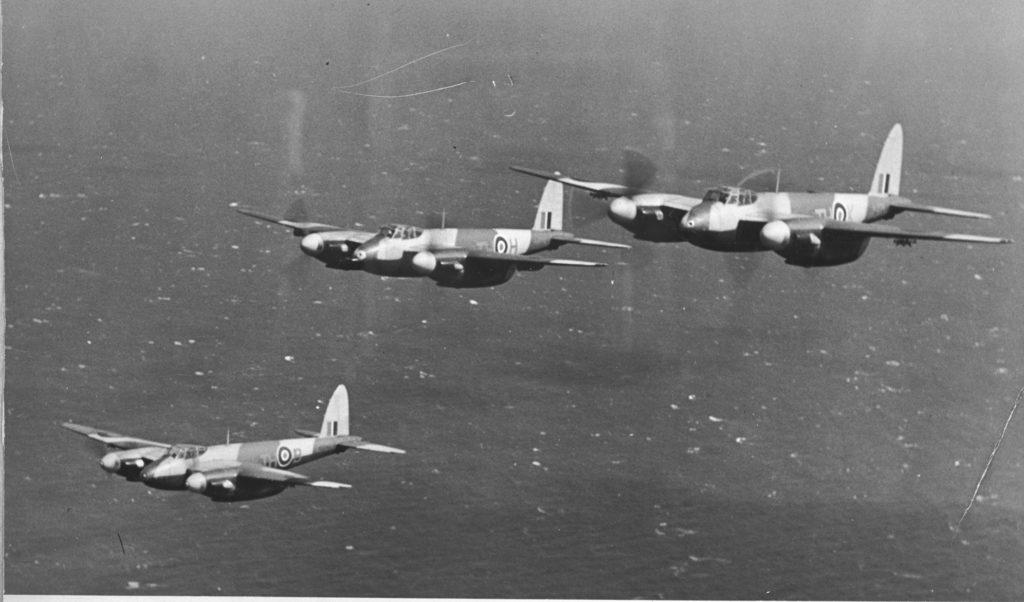Estimated reading time 6 minutes, 8 seconds.
After the defeat of the Luftwaffe during the Battle of Britain, the Allied air forces turned their attention towards the bombing campaign and preparations for the invasion of France.

For Fighter Command, this meant relinquishing control over approximately half of its squadrons to the newly formed 2 Tactical Air Force. The resulting reorganization saw Fighter Command gain control of several ground units and acquire the title of Air Defence of Great Britain (ADGB) on Nov. 15, 1943. This new command, led by Air Marshal Roderic Hill, consisted of 28 squadrons of day-fighters, nine of night fighters, two intruder squadrons and four air-sea rescue squadrons.
Of these 43 squadrons, two were Canadian: 406 in 10 Group and 418 in 11 Group.
The units under Hill’s direction had three tasks. First and foremost was to defend England against German aircraft. Secondly, ADGB was to prevent enemy aircraft from making reconnaissance flights over the invasion staging points in Britain. Finally, the squadrons were to defend against the latest weapon in the German arsenal: the V1 Flying Bomb. By June 1944, the anticipated threat posed by the V1s had not materialized, so most of the squadrons were left to deal with a weakened, but still potent, Luftwaffe. On D-Day, ADGB aircraft took the fight to the enemy and ranged over the landing-area and deep into occupied France.
Of the two Canada units, 406 Squadron had the least activity on D-Day. A night-fighter squadron equipped with Mosquito aircraft, 406 maintained a high rate of sorties throughout the month of June — providing air-sea rescue cover, standing night patrols over the English Channel and conducting the occasional intruder mission into Normandy. The evening of June 6, 1944, found every available aircraft conducting patrols over the channel, but no enemy targets were encountered.
It was not until the following day that 406 Squadron claimed its first and only aerial victory of the campaign. A Dornier 217 twin-engine bomber was encountered near Morlaix airfield in Normandy. The Mosquito flown by Pilot Officer R.L. Green, with A.W. Hillyer (RAF) as the navigator, closed to within 70 metres before firing. After two short bursts from the Mosquito’s formidable armament, both engines of the German aircraft caught fire. Seconds later it blew up and crashed into the sea.
The other Canadian ADGB squadron compensated for the lack of activity by its sister unit when it destroyed no fewer than five enemy aircraft — four of them by one crew. A night intruder squadron, 418 Squadron put on a “maximum” effort and 16 aircraft took to the air during the waning hours of D-Day. An intruder mission was designed to attack German airfields and intercept enemy aircraft while they were taking off or landing. On this evening all of the aircraft were dispatched on “Flower” patrols, which meant they were to concentrate their efforts on German night-fighter fields in support of Allied bombers.

Flight Lt D.A. MacFadyen (pilot) and Flying Officer J.D. Wright (navigator) were near Coulommiers just east of Paris when they spotted a Ju-52 transport aircraft. Giving chase, they chose to attack from behind and below the target, closing to within yards before opening fire. The Ju-52 burst into flames, dived steeply and broke-up before crashing to the ground.
Not that far way near Chateaudun, southwest of the French capital, two other members of 418 Squadron, Flight Lt S. Cotterill (pilot) and Sgt R.H. McKenna (an RAF navigator) came upon another Ju-52 flying low to the ground at an altitude of about 250 metres. After approaching closely to the enemy aircraft, their first burst of fire struck the port wing and engine. The German pilot lost control of the damaged transport and it crashed near a local airfield.
Cotterill and McKenna then flew on to Orleans looking for more targets and were not disappointed. The airfield near Orleans was well lit and had several German aircraft, with navigation lights on, maneuvering to land. The Mosquito crew carefully approached yet another Ju-52 and sent it down in flames with several well-placed rounds. By now the pilots of the other German aircraft realized that an Allied fighter was in the pattern and attempted to flee, albeit with limited success.
Guided by McKenna, Cotterill selected a Ju-188 night-fighter as their next target and shot it out of the sky. Finding themselves in a suddenly empty sky, the 418 Squadron crew returned to the airfield intent on adding insult to injury by strafing it. No sooner had they completed this task than yet another target, another Ju-52 attempting to land, presented itself. It was promptly shot down.
The entire action, from spotting the first enemy aircraft to the destruction of the fourth, had taken little more than 20 minutes, an excellent effort by the RCAF squadrons in ADGB.








